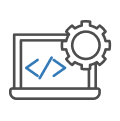Cross-platform mobile applications, you pay for one platform and get all others for free

Cross-platform mobile applications, you pay for one platform and get all others for free
Cross-platform mobile applications are software applications developed to run on multiple mobile operating systems (OS), such as iOS and Android, using a single codebase. These applications offer several advantages, including code reusability, reduced development time, and cost savings.
Cross-platform mobile applications offer a cost-effective and time-efficient approach to mobile app development. They enable businesses and developers to reach a broader audience by creating applications that work seamlessly on different mobile platforms while minimizing development efforts and costs. However, selecting the right cross-platform framework and optimizing for performance and user experience are key considerations for successful cross-platform app development.

Founder of Kvinivel Inc
Call +1 (587) 973 5725

Is it better to use
cross-platform mobile applications?
Cross-platform development significantly reduces costs compared to developing separate native apps for each platform.
Cross-platform apps can reach a wider audience since they’re compatible with both iOS and Android devices.
Popular cross-platform frameworks like React Native, Flutter, Apache Cordova, and Xamarin have thriving developer communities and ecosystems. This means access to a wealth of pre-built components, plugins, and libraries that can speed up development and enhance the functionality of your clients’ apps.

Cross-platform mobile applications –
What for?
Single Codebase: Cross-platform apps are built using a single codebase written in a programming language like JavaScript, Dart, or C#. This codebase can be used to create versions of the app for multiple platforms.
Code Reusability: The primary benefit of cross-platform development is code reusability. Developers can write the app’s logic and functionality once and deploy it on different platforms, eliminating the need to create separate native apps.
Frameworks and Tools: Cross-platform development is facilitated by various frameworks and tools that provide libraries and APIs for creating cross-compatible apps. Examples include React Native, Flutter, Xamarin, and Apache Cordova.
Native-like Experience: Cross-platform apps aim to provide a native-like user experience by rendering user interfaces that mimic the look and feel of native apps. Users should not notice significant differences between a cross-platform app and a native one.
Access to Device Features: Cross-platform frameworks offer ways to access platform-specific features and device capabilities using plugins or native modules. This allows developers to integrate functionalities like camera access, geolocation, and sensors.
Cost Efficiency: Cross-platform development is often more cost-effective than building separate native apps for each platform. It reduces development time and resource requirements, making it attractive to businesses and startups with limited budgets.
Time Savings: Cross-platform development can accelerate the development process. Changes and updates made to the codebase can be deployed simultaneously across different platforms, reducing time to market.
Community and Ecosystem: Popular cross-platform frameworks have active developer communities and ecosystems that provide support, libraries, and pre-built components, streamlining development efforts.
Platform Compatibility: Cross-platform apps can be deployed on multiple app stores, such as the Apple App Store and Google Play Store, allowing for broad distribution to a wider audience.
Challenges: Cross-platform development is not without challenges. Achieving a truly native-level performance and user experience can be complex. Developers must also account for platform-specific differences and limitations.
Performance Optimization: Performance is crucial for user satisfaction. Developers must optimize their apps to run efficiently on various devices and operating systems.
User Interface Customization: While cross-platform apps aim for a consistent look, some customization may be needed to adhere to each platform’s design guidelines and user expectations.
Why collaborating with Kinivel will result in positive outcomes?

Development
We provide a team of experienced developers and testers led by skilled managers. You get a fully finished product with a package of documentation and technical description. We also provide support and additional services.

Cooperation
You can track the development process and make adjustments to the process. Produced real time tracking with detailed reporting

Payment condition
We discuss the payment system with the client in advance. You can choose both a fixed development price and hourly payment for the project. We also practice using customer tracking systems or upwork.

Free consultation
You can get advice on the development you are interested in absolutely free. We will answer all your questions.
What is next?

We discuss possible options for implementation, payment, conditions and all your questions and details of possible cooperation. You make the decision about bargain.

Development and testing of the solution. Flexible system for making changes. Real-time tracking of implementation.

Ready-to-use solution. Technical support and services could be provided.

